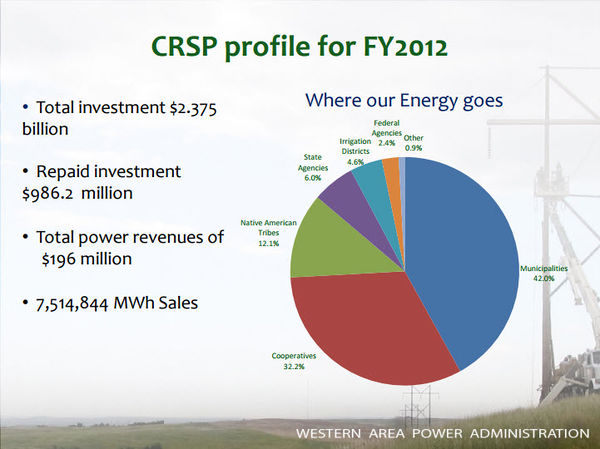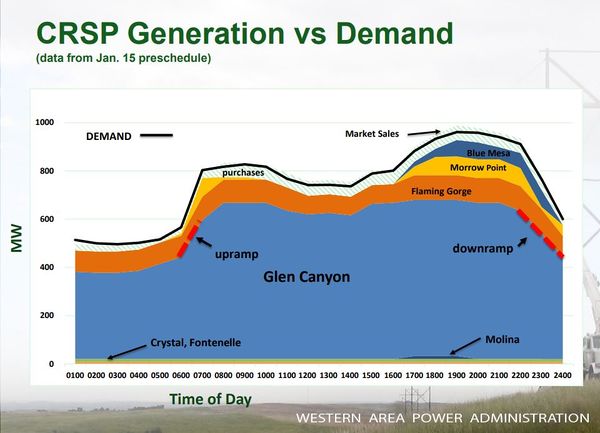Difference between revisions of "HYDROPOWER"
Cellsworth (Talk | contribs) |
Cellsworth (Talk | contribs) |
||
| Line 79: | Line 79: | ||
[[File:CRSP generation v demand.JPG|center|thumb|600px|https://www.usbr.gov/uc/progact/amp/twg/2018-01-25-twg-meeting/AR04.pdf]] | [[File:CRSP generation v demand.JPG|center|thumb|600px|https://www.usbr.gov/uc/progact/amp/twg/2018-01-25-twg-meeting/AR04.pdf]] | ||
| + | |||
| + | |- | ||
| + | ! <h2 style="margin:0; background:#cedff2; font-size:120%; font-weight:bold; border:1px solid #a3b0bf; text-align:left; color:#000; padding:0.2em 0.4em;"> What is Regulation and how does Glen Canyon Dam provide it? </h2> | ||
| + | |- | ||
| + | |style="color:#000;"| | ||
| + | |||
| + | As a control area operator, Western “regulates” the transmission system within a prescribed geographic area. Western is required to react to moment-by-moment changes in electrical demand within this area. Regulation means that “automatic generation control” will be used to adjust the power output of electric generators within a prescribed area in response to changes in the system frequency, time error, and tie-line loading, to maintain the scheduled level of generation in accordance with prescribed NERC criteria. The “record” used to calculate the degree to which Western is responding to these change on the transmission system is called the “ACE” - Area Control Error. | ||
| + | |||
| + | Hydro facilities such as Glen Canyon have an inherent design that allows them to respond rapidly to changes in power system demands. Other control area operators, across the nation, that do not have hydropower plants must either build small units (natural gas or oil-fired being the most likely) or add this capability to the design of larger units. | ||
| + | |||
| + | The transmission system that Western distributes power through is dynamic. Load requirements are constantly changing as a result of either the demands of the customers connected to it or changes that occur in other interconnected power systems. Western maintains the ACE signal to record its response to the fluctuations in system “loading”; (an effort to maintain a balance between power being consumed and power being generated - described above). If more demand is placed on the transmission system than is being generated, the resulting ACE is negative. Generators automatically respond to this condition by increasing generation. If demand is less than generation, ACE is positive. Generators automatically respond to this condition by reducing generation. The targeted ACE is zero. | ||
| + | |||
| + | The ACE signal that is sent to Glen Canyon where it is effectively added to, or subtracted from, the existing scheduled hourly generation base point. Therefore, at any moment during the day or night, Glen Canyon might be producing more or less power than the current hourly megawatt schedule. | ||
| + | |||
| + | The ACE signal is transmitted to Glen Canyon Dam every four seconds. The NERC requirement for regulation is that the ACE must “cross” the zero target every 10 minutes. The frequent “swings” in generation are described in the MOU signed by Reclamation and Western (4): | ||
| + | |||
| + | “These changes which occur many times during the hour are both positive and negative in relation to the schedule. The resulting output from Glen Canyon generators is an envelope of generation swings that are frequent, small in magnitude, the average of which approximates the original schedule.”[https://www.wapa.gov/regions/CRSP/PlanProject/Pages/glen-canyon-operations.aspx] | ||
| + | |||
| + | In addition to daily scheduled fluctuations for power generation, the instantaneous releases from Glen Canyon Dam may also fluctuate to provide 40 megawatts (mw) of system regulation. These instantaneous release adjustments stabilize the electrical generation and transmission system and translate to a range of about 1,200 cfs above or below the hourly scheduled release rate. Under system normal conditions, fluctuations for regulation are typically short lived and generally balance out over the hour with minimal or no noticeable impacts on downstream river flow conditions. | ||
| + | |||
| + | Releases from Glen Canyon Dam can also fluctuate beyond scheduled releases when called upon to respond to unscheduled power outages or power system emergencies. Depending on the severity of the system emergency, the response from Glen Canyon Dam can be significant, within the full range of the operating capacity of the power plant for as long as is necessary to maintain balance in the transmission system. Glen Canyon Dam typically maintains 30 mw (approximately 880 cfs) of generation capacity in reserve in order to respond to a system emergency even when generation rates are already high. System emergencies occur fairly infrequently and typically require small responses from Glen Canyon Dam. However, these responses can have a noticeable impact on the river downstream of Glen Canyon Dam. [https://www.usbr.gov/uc/water/crsp/cs/gcd.html] | ||
|} | |} | ||
Revision as of 16:02, 18 May 2023
|
|
The Hydropower ResourceGlen Canyon Dam is the second highest (710 feet) concrete-arch dam in the United States, second only to Hoover Dam which stands at 726 feet. The 26.2 million acre-feet of water storage capacity in Lake Powell, created by Glen Canyon Dam, serves as a ‘bank account’ of water that is drawn on in times of drought. This stored water has made it possible to successfully weather extended dry periods by sustaining the needs of cities, industries, and agriculture throughout the West. Hydroelectric power produced by the dam’s eight generators helps meet the electrical needs of the West’s rapidly growing population. With a total capacity of 1,320 megawatts, Glen Canyon Powerplant produces around five billion kilowatt-hours of hydroelectric power annually which is distributed by the Western Area Power Administration to Wyoming, Utah, Colorado, New Mexico, Arizona, Nevada, and Nebraska. In addition, revenues from production of hydropower help fund many important environmental programs associated with Glen and Grand canyons. The designation of Glen Canyon National Recreation Area in 1972, underscores the value and importance of the recreation benefits associated with Lake Powell and the Colorado River downstream of the dam. The GCNRA is managed by the National Park Service. Glen Canyon Dam is the key water storage unit of the Colorado River Storage Project, one of the most complex and extensive river resource developments in the world. Without it, development of the Upper Colorado River Basin states’ portion of the Colorado River would not have been possible. [1] LTEMP Resource Goal for the Hydropower ResourceMaintain or increase Glen Canyon Dam electric energy generation, load following capability, and ramp rate capability, and minimize emissions and costs to the greatest extent practicable, consistent with improvement and long-term sustainability of downstream resources. Desired Future Condition for the Hydropower Resource• Glen Canyon Dam capacity and energy generation is maintained and increased, so as to produce the greatest practicable amount of power and energy, consistent with the other DFCs. |
| --- |
Hydropower - Online Training |
--- |
|---|
|







